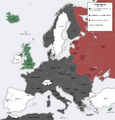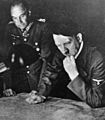Operation Barbarossa facts for kids
Quick facts for kids Operation Barabarossa |
|||||||
|---|---|---|---|---|---|---|---|
| Part of the Eastern Front of World War II | |||||||
 |
|||||||
|
|||||||
| Belligerents | |||||||
| Commanders and leaders | |||||||
| Strength | |||||||
| ~3 million 3,600 tanks, 4,389 aircraft 46,000 artillery pieces |
~5.7 million 12,000-15,000 tanks, 35,000-40,000 aircraft (11,357 combat ready on 22 June 1941) |
||||||
| Casualties and losses | |||||||
| 186,452 killed 40,157 missing 655,179 hurt 2,827 aircraft destroyed 2,735 tanks destroyed |
802,191 killed 1,336,147 hurt 2,835,000 captured. 21,200 aircraft destroyed 20,500 tanks lost |
||||||
Operation Barbarossa (German: Unternehmen Barbarossa, named after Frederick I) was the code name for the European Axis's invasion of the Soviet Union during World War II. It began on 22 June 1941. More than 3 million men attacked along the 2,900 km front, making it the largest military invasion in human history. It also involved 600,000 motor vehicles and 750,000 horses. Planning for the operation started in December 1940 and the attack was to start on May 15. Its main objective was to destroy the Soviet military power and included some Nazi ideological goals, as well as to make use of Russia's rich deposits of natural resources, which would be helpful to continue fighting the war against the Allies.
Even though the Soviets were in a terrible condition, the Axis did not complete its objectives. Tactically, the Germans held some of the most important economic areas of the Soviet Union, mainly in Ukraine. However, the Germans were pushed back from Moscow and could not start an attack as large and long as Operation Barbarossa on the Eastern Front again.
The winter of 1941-42 began unusually early. It was not noted as being particularly bad by the natives but German soldiers accustomed to warmer temperatures were ill prepared. German equipment broke down in the cold, and some men were still wearing summer uniforms which they stuffed with newspapers in an attempt to stay warm. Many German soldiers froze to death in the extreme cold. It was followed in 1942 by "Fall Blau" (Case Blue), intended to take the Caucasus region and its oilfields. This also failed.
The attack opened the Eastern Front of World War II. In Russia it is called the Great Patriotic War. A few years later, after pushing the German soldiers out of Russia, the Soviets were able to launch a counter-invasion into German occupied territories in Eastern Europe. They invaded Germany itself, and started the Battle of Berlin, the final battle before Germany's surrender. Although the Russians eventually repelled the Germans, it was at a tremendous cost. Around five times more Russians died than Germans.
Operation Barbarossa was the largest military operation in human history, both by the number of men involved and by the number of people who died. The operation opened a theatre in which more men were involved than ever before in history.
Images for kids
-
Heinrich Himmler, Rudolf Hess, and Reinhard Heydrich listening to Konrad Meyer at a Generalplan Ost exhibition, 20 March 1941
-
Semyon Timoshenko and Georgy Zhukov in 1940
-
German forces pushing through Latvia, summer 1941
-
German general Heinz Guderian (centre), commander of Panzer Group 2, on 20 August 1941
-
Germans battle Soviet defenders on the streets of Kharkov, 25 October 1941
-
Soviet Ilyushin Il-2s flying over German positions near Moscow
See also
 In Spanish: Operación Barbarroja para niños
In Spanish: Operación Barbarroja para niños



















